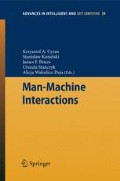Abstract
The sigmoidal membership function applied in the neuro-fuzzy systems with hierarchical input domain partition and gradient tuning method may deteriorate the tuning process. The function’s high value plateau with very low derivative’s value stops the gradient based tuning procedure. This leads to less adequate models and poorer results elaborated by the system. In such systems the membership function should satisfy the condition that the low values of derivatives in respect of the function parameters should be followed by the low values of membership function itself. The points of the domain that do not fulfil this condition may only be isolated point of the domain. The function should have no high membership plateaux. The functions suitable for systems with hierarchical input domain partition are bell-like functions as Gaussian, generalised bell function, (a)symmetric π function.
Access this chapter
Tax calculation will be finalised at checkout
Purchases are for personal use only
Preview
Unable to display preview. Download preview PDF.
References
Czabański, R.: Extraction of fuzzy rules using deterministic annealing integrated with ε-insensitive learning. International Journal of Applied Mathematics and Computer Science 16(3), 357–372 (2006)
Czekalski, P.: Evolution-fuzzy rule based system with parameterized consequences. International Journal of Applied Mathematics and Computer Science 16(3), 373–385 (2006)
Czogała, E., Łęski, J.: Fuzzy and Neuro-Fuzzy Intelligent Systems. In: Studies in Fuzziness and Soft Computing. Physica-Verlag, Heidelberg (2000)
Łęski, J.: Systemy neuronowo-rozmyte. Wydawnictwa Naukowo-Techniczne, Warsaw (2008)
Mackey, M.C., Glass, L.: Oscillation and chaos in physiological control systems. Science 197(4300), 287–289 (1977)
Mamdani, E.H., Assilian, S.: An experiment in linguistic synthesis with a fuzzy logic controller. International Journal of Man-Machine Studies 7(1), 1–13 (1975)
Nelles, O., Fink, A., Babuška, R., Setnes, M.: Comparison of two construction algorithms for Takagi-Sugeno fuzzy models. International Journal of Applied Mathematics and Computer Science 10(4), 835–855 (2000)
Rutkowski, L., Cpałka, K.: A general approach to neuro-fuzzy systems. In: Proceedings of the IEEE International Conference on Fuzzy Systems, pp. 1428–1431 (2001)
Simiński, K.: Neuro-fuzzy system with hierarchical domain partition. In: Proceedings of the International Conference on Computational Intelligence for Modeling, Control and Automation, Vienna, Austria (2008)
Simiński, K.: Data noise reduction in neuro-fuzzy systems. In: Kurzyński, M., Woźniak, M. (eds.) Computer Recognition Systems. Advances in Intelligent and Soft Computing, vol. 3, pp. 203–210. Springer, Heidelberg (2009)
Simiński, K.: Patchwork neuro-fuzzy system with hierarchical domain partition. In: Kurzyński, M., Woźniak, M. (eds.) Computer Recognition Systems. Advances in Intelligent and Soft Computing, vol. 3, pp. 13–20. Springer, Heidelberg (2009)
Sugeno, M., Kang, G.T.: Structure identification of fuzzy model. Fuzzy Sets and Systems 28(1), 15–33 (1988)
Takagi, T., Sugeno, M.: Fuzzy identification of systems and its application to modeling and control. IEEE Transactions on Systems, Man and Cybernetics 15(1), 116–132 (1985)
Tsukamoto, Y.: An approach to fuzzy reasoning method. In: Gupta, M.M., Ragade, R.K., Yager, R.R. (eds.) Advances in Fuzzy Set Theory and Applications, pp. 137–149 (1979)
Author information
Authors and Affiliations
Editor information
Editors and Affiliations
Rights and permissions
Copyright information
© 2009 Springer-Verlag Berlin Heidelberg
About this paper
Cite this paper
Simiński, K. (2009). Remark on Membership Functions in Neuro-Fuzzy Systems. In: Cyran, K.A., Kozielski, S., Peters, J.F., Stańczyk, U., Wakulicz-Deja, A. (eds) Man-Machine Interactions. Advances in Intelligent and Soft Computing, vol 59. Springer, Berlin, Heidelberg. https://doi.org/10.1007/978-3-642-00563-3_30
Download citation
DOI: https://doi.org/10.1007/978-3-642-00563-3_30
Publisher Name: Springer, Berlin, Heidelberg
Print ISBN: 978-3-642-00562-6
Online ISBN: 978-3-642-00563-3
eBook Packages: EngineeringEngineering (R0)

